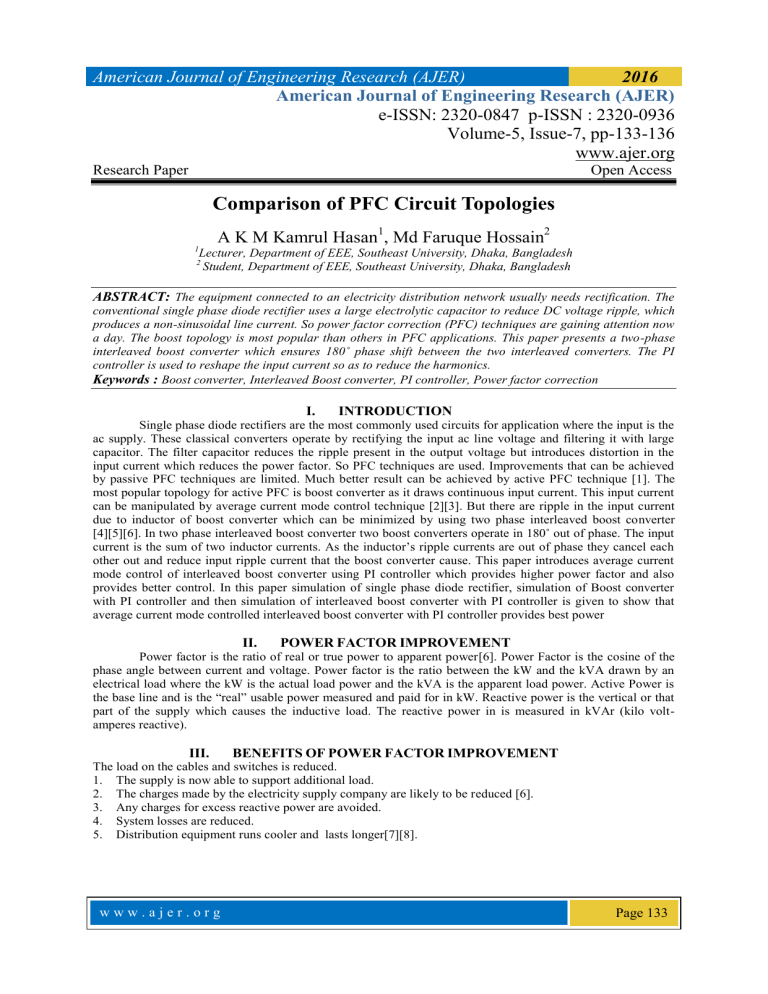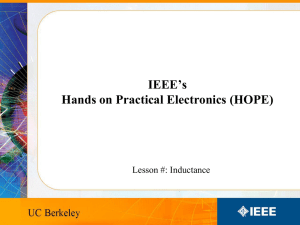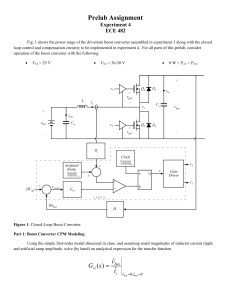Comparison of PFC Circuit Topologies

American Journal of Engineering Research (AJER)
2016
American Journal of Engineering Research (AJER)
e-ISSN: 2320-0847 p-ISSN : 2320-0936
Volume-5, Issue-7, pp-133-136 www.ajer.org
Research Paper Open Access
Comparison of PFC Circuit Topologies
A K M Kamrul Hasan
1
, Md Faruque Hossain
2
1
Lecturer, Department of EEE, Southeast University, Dhaka, Bangladesh
2
Student, Department of EEE, Southeast University, Dhaka, Bangladesh
ABSTRACT:
The equipment connected to an electricity distribution network usually needs rectification. The conventional single phase diode rectifier uses a large electrolytic capacitor to reduce DC voltage ripple, which produces a non-sinusoidal line current. So power factor correction (PFC) techniques are gaining attention now a day. The boost topology is most popular than others in PFC applications. This paper presents a two-phase interleaved boost converter which ensures 180˚ phase shift between the two interleaved converters. The PI controller is used to reshape the input current so as to reduce the harmonics.
Keywords :
Boost converter, Interleaved Boost converter, PI controller, Power factor correction
I.
INTRODUCTION
Single phase diode rectifiers are the most commonly used circuits for application where the input is the ac supply. These classical converters operate by rectifying the input ac line voltage and filtering it with large capacitor. The filter capacitor reduces the ripple present in the output voltage but introduces distortion in the input current which reduces the power factor. So PFC techniques are used. Improvements that can be achieved by passive PFC techniques are limited. Much better result can be achieved by active PFC technique [1]. The most popular topology for active PFC is boost converter as it draws continuous input current. This input current can be manipulated by average current mode control technique [2][3]. But there are ripple in the input current due to inductor of boost converter which can be minimized by using two phase interleaved boost converter
[4][5][6]. In two phase interleaved boost converter two boost converters operate in 180˚ out of phase. The input current is the sum of two inductor currents. As the inductor’s ripple currents are out of phase they cancel each other out and reduce input ripple current that the boost converter cause. This paper introduces average current mode control of interleaved boost converter using PI controller which provides higher power factor and also provides better control. In this paper simulation of single phase diode rectifier, simulation of Boost converter with PI controller and then simulation of interleaved boost converter with PI controller is given to show that average current mode controlled interleaved boost converter with PI controller provides best power
II.
POWER FACTOR IMPROVEMENT
Power factor is the ratio of real or true power to apparent power[6]. Power Factor is the cosine of the phase angle between current and voltage. Power factor is the ratio between the kW and the kVA drawn by an electrical load where the kW is the actual load power and the kVA is the apparent load power. Active Power is the base line and is the “real” usable power measured and paid for in kW. Reactive power is the vertical or that part of the supply which causes the inductive load. The reactive power in is measured in kVAr (kilo voltamperes reactive).
III.
BENEFITS OF POWER FACTOR IMPROVEMENT
The load on the cables and switches is reduced.
1.
The supply is now able to support additional load.
2.
The charges made by the electricity supply company are likely to be reduced [6].
3.
Any charges for excess reactive power are avoided.
4.
System losses are reduced.
5.
Distribution equipment runs cooler and lasts longer[7][8]. w w w . a j e r . o r g Page 133
American Journal of Engineering Research (AJER)
IV.
SIMULATION BASED ANALYSIS OF POWER FACTOR IMPROVEMENT
2016
(a) Single phase diode rectifier.
Single phase diode rectifiers are commonly used for ac-dc conversion[9]. But the rectified dc voltage contains fair amount of ripple. To reduce this ripple a filter capacitor is used[10]. The filter capacitor reduces the ripple present in the output voltage but introduces distortion in the input current which reduces the power factor[11]. So PFC techniques are used. Improvements that can be achieved by passive PFC techniques are limited. Much better result can be achieved by active PFC technique[12][13][14][15][16]. The most popular topology for active PFC is boost converter. This input current can be manipulated by average current mode control work is carried out in MATLAB- Simulink capacitor voltage capacitor the power factor becomes poor and introduces several problems including reduction of available power and increased loss.
Fig 1: Simulink diagram of single phase diode rectifier
Fig 2: Active and Reactive power waveform
At first simulation of single phase diode rectifier is performed. The MATLAB-Simulink model of single phase diode rectifier with filter capacitor is shown in Fig.1. The Active and reactive power waveforms are shown in Fig.2.Power factor can be calculated by active and reactive power. In this case the input power factor is 0.8756.
(b)Boost converter and interleaved boost converter
For boost converter
To prevent the problem of pulsating input current PFC techniques are used[8]. Best result can be obtained by using active PFC techniques based on switch mode power converters[16]. The boost topology is by far more popular than other PFC techniques. The circuit diagram of a boost converter is shown in below w w w . a j e r . o r g Page 134
American Journal of Engineering Research (AJER) 2016
Fig 3 : Circuit diagram and SIMULINK diagram of boost converter
When the switch S is on the current IL rises and flows throughinductor L. When switch S is off the current IL decreases and flows through L, diode D5, C, and R. The current IL falls until switch S is turned on again.So when switch S is on 𝑑𝐼
𝐿 𝑑𝑡
=
𝑉 𝑖𝑛
(1)
𝐿
Again when switch S is off 𝑑𝐼
𝐿 𝑑𝑡
=
𝑉 𝑜
−𝑉 𝑖𝑛
(2)
𝐿
Here Vin is the rectified input voltage and Vo is the output voltage. So the boost converter draws continuous input current. This input current can be controlled to follow a sinusoidal reference using average current mode control technique. To improve the power factor boost converter can be used. The MATLAB-
Simulink model using boost converter is shown in Fig.3. The active and reactive power wave forms are shown in Fig.4.
Fig 4: Active and Reactive power waveform
Power factor can be calculated by active and reactive power calculation. In this case the input power factor is
0.9877.
V.
RESULT
The comparison of input power factor for different circuit topologies has been shown in following
Table 1. It is seen that best power factor is obtained in case of boost converter other than circuit topology.
Table 1: Various power factor for different topology
Circuit topology
Single phase diode rectifier
Boost converter
Power factor
0.8756
0.9877 w w w . a j e r . o r g Page 135
American Journal of Engineering Research (AJER) 2016
VI.
CONCLUSION
The power factor correction circuits have been simulated by MATLAB Simulink in this research. It is seen that best power factor is obtained in case of boost converter with average current mode control using PI controller. The power factor may be further improved if fuzzy controller is used in place of PI controller. Also interleaved boost converter can be another improvement as well.
[1].
[2].
[3].
[4].
[5].
[6].
[7].
[8].
[9].
[10].
[11].
[12].
[13].
[14].
[15].
[16].
REFERENCES
Muhammad H. Rashid, Power Electronics Handbook(Academic Press, 2001).
Y.-S. Jung and M.-J. Youn, sampling effect in continuous-time small-signal modeling of average-current mode control, IEE Proc. –
Electr. Power Appl., vol. 149, no.4, July 2002.
Wa Ma, Mingyu Wang, Shuxi Liu, Shan Li, and Peng Yu, Stabilizing the Average-Current-Mode-Controlled Boost PFC Converter via Washout-Filter-Aided MethodIEEE Transactions on Circuits and Systems-II, Express Briefs, vol. 58, no. 9, September 2011.
Jian-Min Wang, Sen-Tung Wu, Yanfeng Jiang, and Huang-Jen Chiu, A Dual-ModeController for the Boost PFC converter, IEEE
Transactions on Industrial Electronics, vol. 58, no.1, January 2011.
Po-Wa Lee, Yim-Shu Lee, David K. W. Cheng, and Xiu-Cheng Liu, Steady-State Analysis of an Interleaved Boost Converter with
Coupled Inductors,IEEE Transactions on Industrial Electronics, vol. 47, no. 4, August 2000.
P. Vijaya Prasuna, J. V. G. Rama Rao, Ch. M. Lakshmi, Improvement in Power Factor & THD Using Dual Boost
Converter,International Journal of Engineering Research and Applications, vol. 2, Issue4, July-August 2012, pp.2368-2376.
N. G Hingorani& Laszlo G yugyi, “Understanding FACTS: concepts and
Abhijit Chakrabarti & Sunita Halder, “Power System Analysis Operation and Control”. Prentice Hall of India Pvt. Limited, New
Delhi, 2006.
Dr.B.R.Gupta & Er.Vandana Singhal, “Power System Operation and Control”, S. Chand Publications.
Marlar Thein Oo, Ei Ei Cho, “Proceedings of World Academy of Science, Engineering and Technology”, ISSN, Volume 32,
PP.2070-3740, 2008.
Sharaf AM and Huang H, “Nonline ar Load Reactive Compensation and Power Factor Correction Using Modulated Power Filter”.
Fitzgerald A E, Charles Kingsley, Jr Stephen D Umans,“ ELECTRIC MACHINERY”.
Nicolae DV “Electric Motor Performance Improvement Using Auxiliary Windings and Capacitance Injection”.
Salvador Acevedo ,Armando RLlamas, Jesús A Baez,Jorge A de los Reyes“Filters For Power Factor Correction in the Presence of
Non-Linear Loads” IEEE
Suman Maiti , Chandan Chakraborty, “A New Instantaneous Reactive Power Based MRAS For Sensor less Induction Motor
Drive”, PP 1314–1326 ,2010.
C. K. Tse and M. H. L. Chow,“Theoretical study of Switching Converters with Power Factor Correction and Voltage
Regulation,”IEEE Transactions on Circuits and Systems I,vol. 47, no. 7, pp. 1047-1055, July 2000. w w w . a j e r . o r g Page 136

